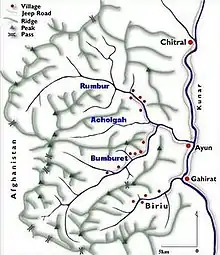Kalasha Valleys
The Kalasha Valleys (Kalasha-mondr: Kaĺaśa Desh; Urdu: وادی کالاش) are valleys in Chitral District in northern Pakistan. The valleys are surrounded by the Hindu Kush mountain range. The inhabitants of the valley are the Kalash people, who have a unique culture, language and follow a form of ancient Hinduism.[1] As such, the Kalasha Valleys are a source of attraction for Pakistani as well as International tourists. There are three main valleys.[2][3][4] The largest and most populous valley is Bumburet (Mumuret), reached by a road from Ayun in the Kunar Valley. Rumbur is a side valleys north of Bumburet. The third valley, Biriu (Birir), is a side valley of the Kunar Valley south of Bumburet.
Kalash وادی کالاش | |
|---|---|
%253B_Tahsin_Shah_01.jpg.webp) The three remote valleys are home to the animist Kalash people | |
 Kalash وادی کالاش Kalash Valley | |
| Coordinates: 35°42′2″N 71°41′29″E | |
| Country | Pakistan |
| Province | Khyber Pakhtunkhwa |
| District | Chitral District |
| Area | |
| • Total | 456.58 km2 (176.29 sq mi) |
| Elevation | 1,670 m (5,480 ft) |
| Population (2003) | |
| • Total | 9,000 |
| • Density | 20/km2 (51/sq mi) |
| Time zone | UTC+5 (PST) |
Kalash people

Kalash people are the smallest religious as well as the ethnic minority of Pakistan. Their customs and traditions are contradictory to the Islamic and Pakistani culture. The Kalash religion is polytheist faith similar to ancient forms of Hinduism and the people offer sacrifices for their gods. Their culture is interlinked with their religion and based upon several festivals and celebrations. The people generally do not intermarry or cohabit regions with local Muslims but neither are they hostile towards them. The people are under legal and constitutional protection of the State of Pakistan as a scheduled tribe.
Gallery
 Typical homes in the Kalasha Valleys
Typical homes in the Kalasha Valleys
 A school in the Kalasha Valleys
A school in the Kalasha Valleys
See also
- Ancient Greeks
- Alexander the Great
- Kaghan Valley
- Neelam Valley
- Naltar Valley
- Hunza Valley
| Wikimedia Commons has media related to Kalasha Valleys. |
References
- Minahan, James B. (10 February 2014). Ethnic Groups of North, East, and Central Asia: An Encyclopedia. ABC-CLIO. p. 205. ISBN 9781610690188.
Living in the high mountain valleys, the Nuristani retained their ancient culture and their religion, a form of ancient Hinduism with many customs and rituals developed locally. Certain deities were revered only by one tribe or community, but one deity was universally worshipped by all Nuristani as the Creator, the Hindu god Yama Raja, called imr'o or imra by the Nuristani tribes.
- "The Kalasha Valleys". Kalasha Heritage Conservation. Archived from the original on 11 November 2014. Retrieved 8 September 2014.
- http://www.tourism.gov.pk/kalash_valley_nothern_areas.htm
- http://www.press.umich.edu/pdf/0472097830-02.pdf